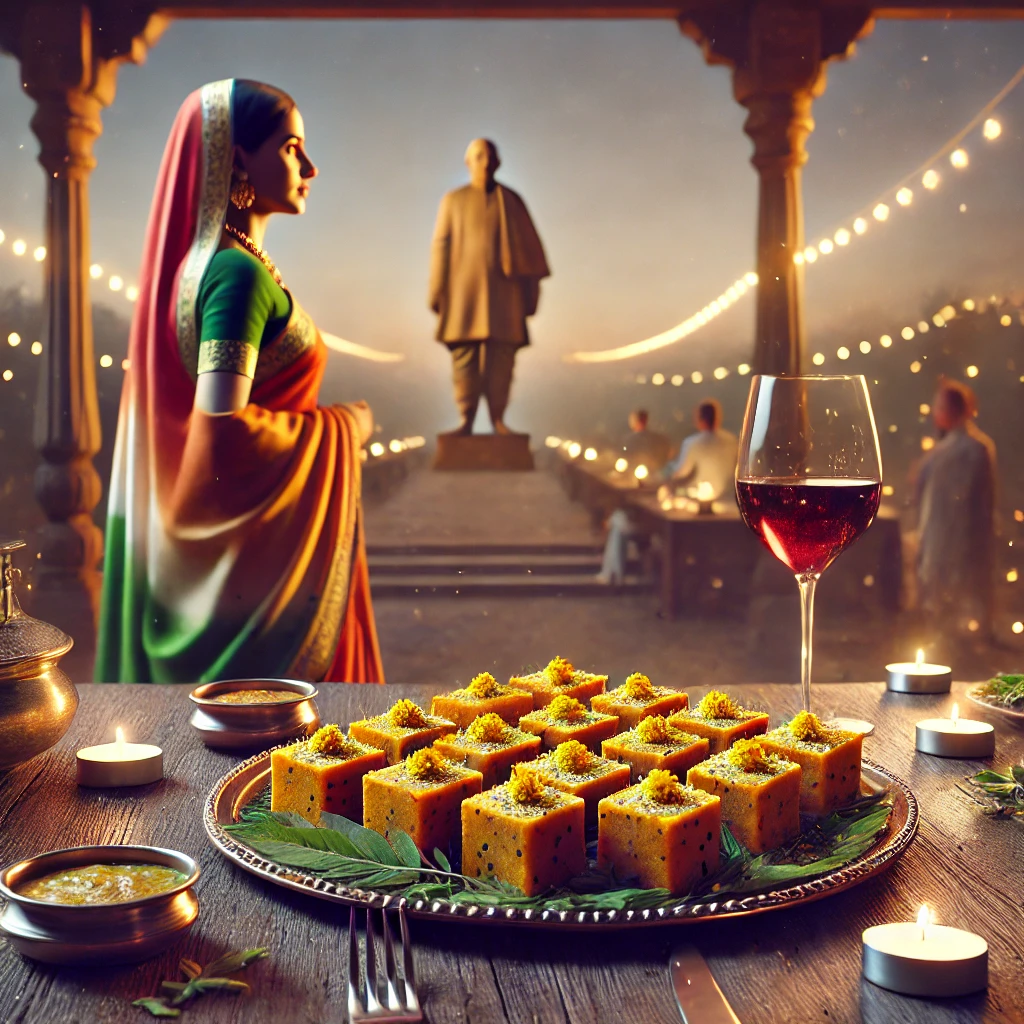Introduction
Fluffy, tangy, and subtly spiced, Dhokla is a beloved steamed snack from the Indian state of Gujarat. Its unique combination of textures and flavors presents a delightful challenge—and opportunity—for wine lovers looking to pair thoughtfully with Indian cuisine. This guide will help you understand how to complement Dhokla’s signature taste with wines that elevate rather than overwhelm it.
Dhokla & Cultural Context
Dhokla dates back to ancient Gujarat, where it began as a savory fermented dish made from rice and lentils. Over time, it evolved into today’s quick-cooking version using gram flour (besan). It’s a staple during festivals, religious ceremonies, and everyday meals alike—valued for its lightness, digestibility, and subtle spice.
Key Ingredients & Preparation Style
- Main ingredients: Gram flour (besan), yogurt, lemon juice, green chili, ginger, mustard seeds, curry leaves, sugar.
- Preparation: The batter is leavened with baking soda or fruit salt (like Eno), steamed until fluffy, then topped with a tempered mix of mustard seeds and curry leaves. Sometimes garnished with grated coconut and fresh coriander.
Flavor & Texture Profile
- Taste: Tangy (from lemon and yogurt), mildly spicy (chili-ginger), slightly sweet (sugar syrup drizzle).
- Texture: Soft, spongy, airy.
- Aromatic accents: Toasted mustard seeds, curry leaves, and hing (asafoetida).
Science Behind Spice & Wine Interactions
Wine Components at Play:
- Acidity balances the tanginess and refreshes the palate.
- Sweetness counters heat and harmonizes the sugar component.
- Low alcohol prevents the burn that can come with chili spice.
- Tannins can clash with spice and bitterness, so best minimized.
Spice Interactions:
- Gingerol (from ginger) and capsaicin (from chilies) can be intensified by high-alcohol or heavily tannic wines.
- Mustard seed oils can clash with overly oaked wines or those with pronounced bitterness.
Ideal Wine Pairings: Science & Art of Selection
🥂 White Wines
- Riesling (Germany – Kabinett or off-dry styles)
- Why it Works: Bright acidity complements Dhokla’s tanginess; slight sweetness offsets chili heat.
- Regions/Producers: Dr. Loosen (Mosel), Donnhoff (Nahe), Leitz (Rheingau).
- Albariño (Spain – Rías Baixas)
- Why it Works: Crisp citrus and saline notes mirror the dish’s brightness; no oak to clash with spice.
- Regions/Producers: Pazo Señorans, Martín Códax, Bodegas Fillaboa.
- Gewürztraminer (Alsace or New Zealand)
- Why it Works: Floral and lychee-driven, it plays well with Dhokla’s herbal-tempered sweetness.
- Regions/Producers: Domaine Weinbach (Alsace), Villa Maria (New Zealand).
🍇 Red Wines
- Pinot Noir (New Zealand or Oregon)
- Why it Works: Light body, gentle tannins, and red berry notes pair delicately with the dish.
- Regions/Producers: Cloudy Bay (NZ), Domaine Drouhin (Oregon), Ata Rangi (Martinborough).
- Lambrusco Secco (Italy – Emilia-Romagna)
- Why it Works: Lightly sparkling, fruity but dry—refreshes the palate and contrasts the soft texture.
- Regions/Producers: Cleto Chiarli, Medici Ermete.
- Gamay (France – Beaujolais Villages)
- Why it Works: Vibrant fruit, minimal tannins, and a juicy finish that won’t overpower.
- Regions/Producers: Jean Foillard, Château Thivin.
Unexpected Pairings: Lesser-Known but Great Choices
- Sparkling Rosé (Brut or off-dry)
- Why it Works: The bubbles lift the texture, rosé fruit bridges sweet and spice, and acidity cuts richness.
- Txakolina (Basque Country, Spain)
- Why it Works: High acid, slight effervescence, and green citrus zing make this a lively companion.
- Orange Wines (lightly macerated whites)
- Why it Works: Tea-like tannins and herbal complexity echo the mustard seed and curry leaf notes.
Wines to Avoid & Common Mistakes
| Mismatched Pairing | Why It Doesn’t Work | Better Alternative | Example Wine | Example Reason | Suggested Wine |
|---|---|---|---|---|---|
| High-Tannin Reds (Cabernet) | Overpowers delicate flavors; intensifies spice | Low-tannin, fruity red | Napa Cabernet Sauvignon | Too bold, clashes with spice | Beaujolais Gamay |
| Oaky Chardonnay | Vanilla/oak notes clash with mustard & lemon | Unoaked aromatic white | California oaked Chardonnay | Heavy and buttery; fights with texture | Albariño or Gewürztraminer |
| High-Alcohol Zinfandel | Heat + spice = fire | Low-alcohol off-dry white | Zinfandel from Lodi | Too intense for mild dish | Kabinett Riesling |
Final Thoughts & Expert Tips
Key takeaway: For Dhokla, think light, zippy, and aromatic. Wines with bright acidity and subtle sweetness do best, while bold tannins and oak can throw off the balance.
Fun Fact: In Gujarati households, Dhokla batter is often fermented overnight for extra flavor—just like natural wine!
Personal Tip: A glass of chilled off-dry Riesling with freshly steamed Dhokla, topped with coconut and coriander, is pure afternoon bliss.
Recipe & Wine-Friendly Adjustments
Ingredients
- 1 cup gram flour (besan)
- ½ cup yogurt
- ½ tsp turmeric
- 1 tbsp lemon juice
- 1 tsp ginger-green chili paste
- Salt to taste
- 1 tsp Eno fruit salt or baking soda
- 1 tsp mustard seeds
- Curry leaves, hing
- 1 tsp sugar (for syrup)
- Chopped coriander & grated coconut (optional garnish)
Preparation
- Mix besan, yogurt, lemon juice, turmeric, ginger-chili paste, and salt into a smooth batter. Let it rest 30 minutes.
- Add Eno just before steaming; pour into greased tray. Steam for 15-20 minutes.
- In hot oil, temper mustard seeds, curry leaves, and a pinch of hing.
- Drizzle over steamed dhokla.
- Optional: Dissolve sugar in warm water, drizzle lightly. Garnish with coriander and coconut.
Wine-Friendly Modifications
- Skip or reduce the chili for more versatile pairing.
- Use lime zest instead of lemon juice for a softer citrus note.
- Light sugar syrup enhances compatibility with off-dry whites.
Serving Suggestions
- Cut into squares or diamonds, serve on a platter.
- Pair with chilled white wine in stemless glasses for a casual, elegant presentation.
- Side of cilantro-mint chutney works beautifully—especially with Riesling or Albariño.


